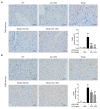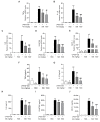Alanyl-Glutamine Protects against Lipopolysaccharide-Induced Liver Injury in Mice via Alleviating Oxidative Stress, Inhibiting Inflammation, and Regulating Autophagy
- PMID: 35739966
- PMCID: PMC9220087
- DOI: 10.3390/antiox11061070
Alanyl-Glutamine Protects against Lipopolysaccharide-Induced Liver Injury in Mice via Alleviating Oxidative Stress, Inhibiting Inflammation, and Regulating Autophagy
Abstract
Acute liver injury is a worldwide problem with a high rate of morbidity and mortality, and effective pharmacological therapies are still urgently needed. Alanyl-glutamine (Ala-Gln), a dipeptide formed from L-alanine and L-glutamine, is known as a protective compound that is involved in various tissue injuries, but there are limited reports regarding the effects of Ala-Gln in acute liver injury. This present study aimed to investigate the protective effects of Ala-Gln in lipopolysaccharide (LPS)-induced acute liver injury in mice, with a focus on inflammatory responses and oxidative stress. The acute liver injury induced using LPS (50 μg/kg) and D-galactosamine (D-Gal) (400 mg/kg) stimulation in mice was significantly attenuated after Ala-Gln treatment (500 and 1500 mg/kg), as evidenced by reduced plasma alanine transaminase (ALT) (p < 0.01, p < 0.001), aspartate transaminase (AST) (p < 0.05, p < 0.001), and lactate dehydrogenase (LDH) (p < 0.01, p < 0.001) levels, and accompanied by improved histopathological changes. In addition, LPS/D-Gal-induced hepatic apoptosis was also alleviated by Ala-Gln administration, as shown by a greatly decreased ratio of TUNEL-positive hepatocytes, from approximately 10% to 2%, and markedly reduced protein levels of cleaved caspase-3 (p < 0.05, p < 0.001) in liver. Moreover, we found that LPS/D-Gal-triggered oxidative stress was suppressed after Ala-Gln treatment, the effect of which might be dependent on the elevation of SOD and GPX activities, and on GSH levels in liver. Interestingly, we observed that Ala-Gln clearly inhibited LPS/D-Gal exposure-induced macrophage accumulation and the production of proinflammatory factors in the liver. Furthermore, Ala-Gln greatly regulated autophagy in the liver in LPS/D-Gal-treated mice. Using RAW264.7 cells, we confirmed the anti-inflammatory role of Ala-Gln-targeting macrophages.
Keywords: acute liver injury; alanyl-glutamine; apoptosis; inflammation; oxidative stress.
Conflict of interest statement
The authors declare no conflict of interest.
Figures








Similar articles
-
Alanyl-Glutamine Protects Mice against Methionine- and Choline-Deficient-Diet-Induced Steatohepatitis and Fibrosis by Modulating Oxidative Stress and Inflammation.Nutrients. 2022 Sep 15;14(18):3796. doi: 10.3390/nu14183796. Nutrients. 2022. PMID: 36145172 Free PMC article.
-
Oral free and dipeptide forms of glutamine supplementation attenuate oxidative stress and inflammation induced by endotoxemia.Nutrition. 2014 May;30(5):602-11. doi: 10.1016/j.nut.2013.10.019. Epub 2013 Oct 31. Nutrition. 2014. PMID: 24698353
-
Oleoylethanolamide Protects Against Acute Liver Injury by Regulating Nrf-2/HO-1 and NLRP3 Pathways in Mice.Front Pharmacol. 2021 Jan 18;11:605065. doi: 10.3389/fphar.2020.605065. eCollection 2020. Front Pharmacol. 2021. PMID: 33536915 Free PMC article.
-
Preventive effects of interleukin-6 in lipopolysaccharide/d-galactosamine induced acute liver injury via regulating inflammatory response in hepatic macrophages.Int Immunopharmacol. 2017 Oct;51:99-106. doi: 10.1016/j.intimp.2017.08.009. Epub 2017 Aug 17. Int Immunopharmacol. 2017. PMID: 28822324
-
Protective role of puerarin on LPS/D-Gal induced acute liver injury via restoring autophagy.Am J Transl Res. 2018 Mar 15;10(3):957-965. eCollection 2018. Am J Transl Res. 2018. PMID: 29636885 Free PMC article.
Cited by
-
Effects of Alanyl-Glutamine Dipeptide Supplementation on Growth Performance, Nutrient Digestibility, Digestive Enzyme Activity, Immunity, and Antioxidant Status in Growing Laying Hens.Animals (Basel). 2024 Oct 11;14(20):2934. doi: 10.3390/ani14202934. Animals (Basel). 2024. PMID: 39457865 Free PMC article.
-
Alanyl-Glutamine Protects Mice against Methionine- and Choline-Deficient-Diet-Induced Steatohepatitis and Fibrosis by Modulating Oxidative Stress and Inflammation.Nutrients. 2022 Sep 15;14(18):3796. doi: 10.3390/nu14183796. Nutrients. 2022. PMID: 36145172 Free PMC article.
-
Integrated Analysis of Gut Microbiome and Liver Metabolome to Evaluate the Effects of Fecal Microbiota Transplantation on Lipopolysaccharide/D-galactosamine-Induced Acute Liver Injury in Mice.Nutrients. 2023 Feb 24;15(5):1149. doi: 10.3390/nu15051149. Nutrients. 2023. PMID: 36904149 Free PMC article.
-
Alanyl-Glutamine Dipeptide Attenuates Non-Alcoholic Fatty Liver Disease Induced by a High-Fat Diet in Mice by Improving Gut Microbiota Dysbiosis.Nutrients. 2023 Sep 14;15(18):3988. doi: 10.3390/nu15183988. Nutrients. 2023. PMID: 37764772 Free PMC article.
-
Multiplex gene knockout raises Ala-Gln production by Escherichia coli expressing amino acid ester acyltransferase.Appl Microbiol Biotechnol. 2023 Jun;107(11):3523-3533. doi: 10.1007/s00253-023-12550-z. Epub 2023 May 5. Appl Microbiol Biotechnol. 2023. PMID: 37145161 Free PMC article.
References
Grants and funding
LinkOut - more resources
Full Text Sources
Other Literature Sources
Research Materials

